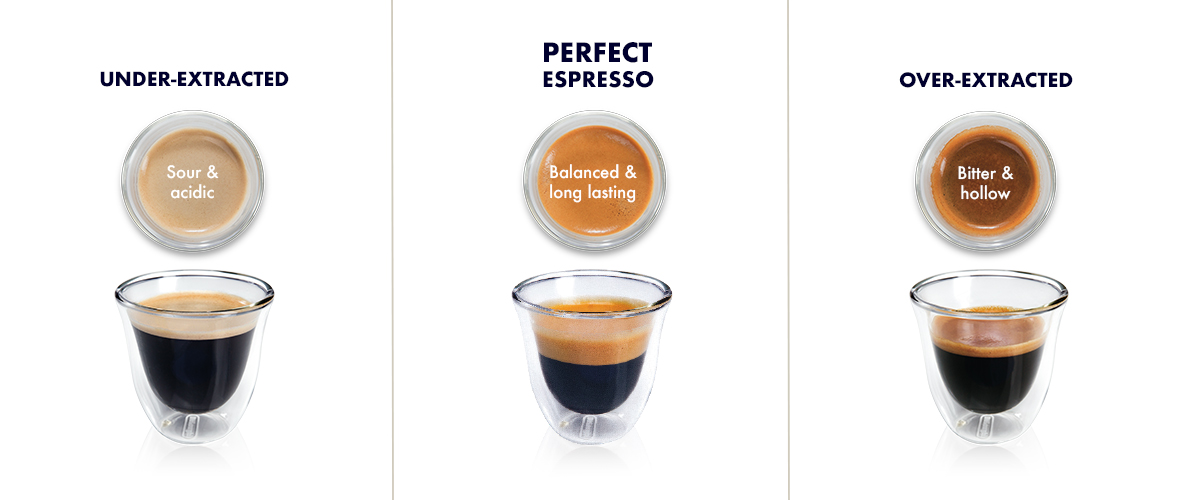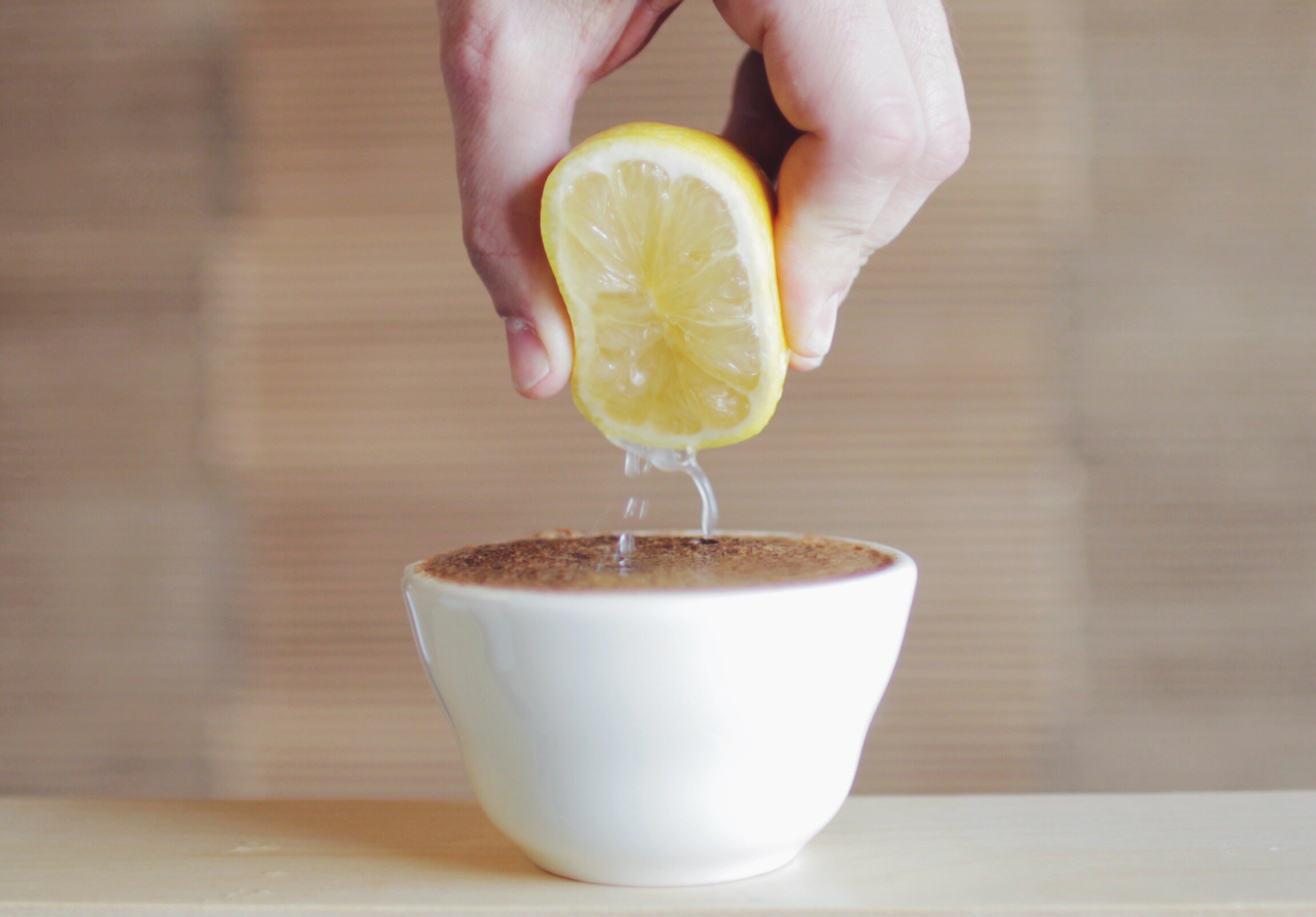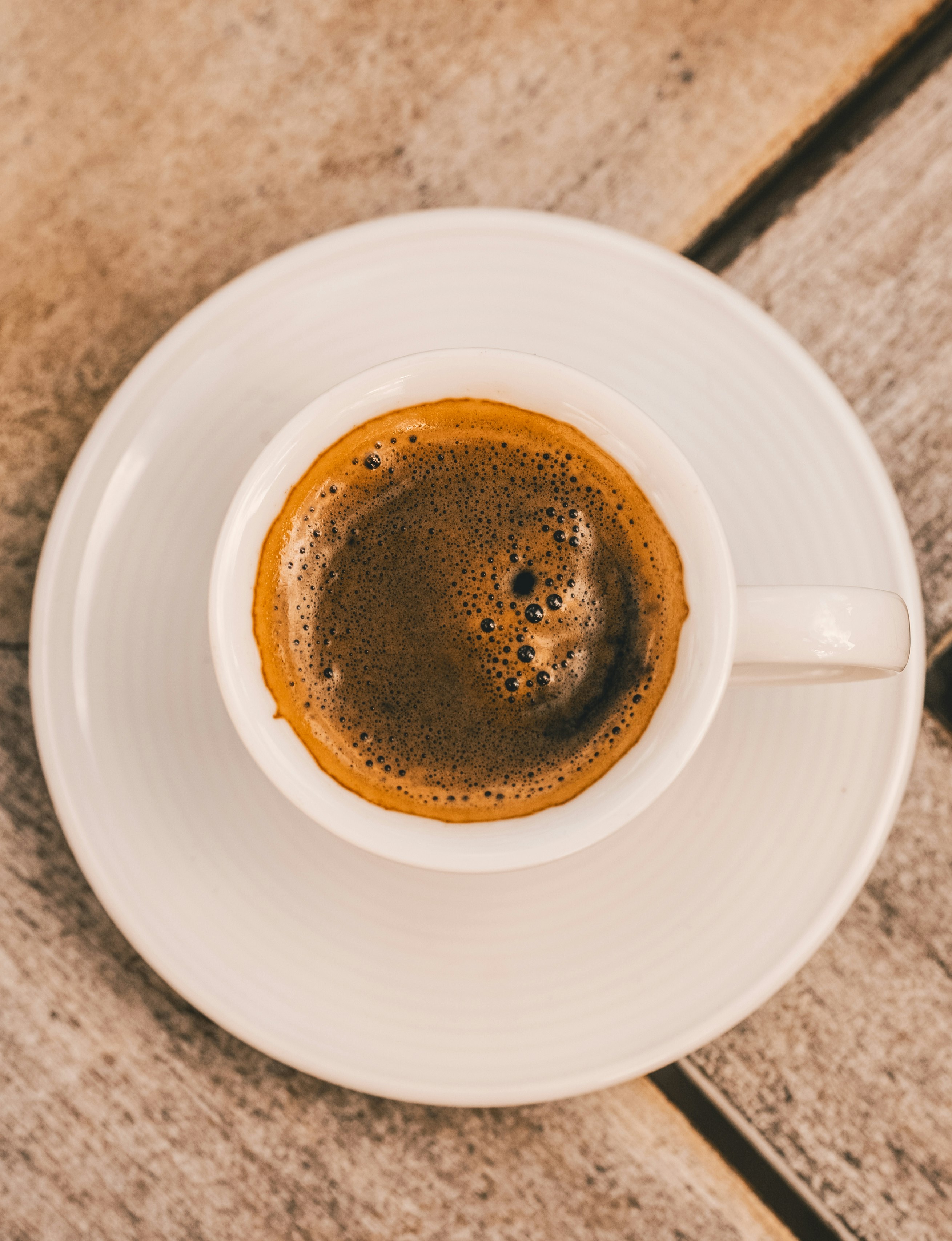
- After going through the Extraction Basics, steeped in concept and math, this article will cover some of the practical aspects of extraction, helping you get your taste buds on, each to varying degrees in the extraction process. We’re not talking about micro-ingredients like lipids, carbohydrates, mathematical formulas… Just flavour & taste and how to get the best extraction without breaking the boundaries of under-extraction or over-extraction.

Three extremes of coffee extraction, From Under, Ideal to Over-Extract Extraction is everything water takes from coffee” – After countless concepts found, this is the simplest way to understand what extraction is.
Matt Perger, Baristahustle
To get a good extract
Again, each roasted coffee bean has about 28% (by weight) soluble in water. This means you can extract ~28% by mass of coffee beans in water. The rest is cellulose, which helps form the structure of the grain. The structure of coffee beans is extremely dense and complex; water cannot pass through and collect all the flavours in its path. To aid in this process, we have to grind the coffee to increase the surface area of the beans so that the water can easily pick up all the flavours.
In an ideal condition, we would grind the coffee into a fine powder, throw it in the water so that it dissolves all the flavors. Unfortunately, this results in an extremely bitter cup of coffee – over-extraction. Not all flavors of coffee are good, so you have to control the number of solutes through extraction to create a delicious cup. On the other hand, you can’t simply use more ground coffee and extract less to avoid over-extracted flavors. Poor extraction (under-extraction) is also very bad.

Extraction is a path where you try to move between Over & Under-extract So the simplest way to talk about coffee extraction – It’s like a road, where we’re always trying to drive the extraction wheel between two lanes, away from the Under-extraction and Over-extraction boundaries. ; This is a super classic example that will follow you until the end of the article.
Under-extraction
Under-extraction happens when you don’t get enough flavor from ground coffee. There are still a lot of soluble compounds in coffee grounds that can provide balance. The most obvious example is a shortened espresso shot – a typical ristretto. It’s sour, lacking in sweetness, a little salty (though a bit challenging to feel) with a quick finish on the palate, leaving almost no aftertaste. These four are the most apparent elements of Under-extraction. Among these, sourness can be considered a “typical characteristic” of a “young” extract.
Sour / Sourness
In the case of coffee. The first compounds extracted from coffee are acids and fats. Acids, contributing to the aroma and sourness, give the coffee a lively – fresh feeling. Acids are also the simplest compounds (molecularly), so water can easily dissolve them into liquid coffee. On the other hand, the oils or fats in coffee are far from simple – chemically speaking. Instead, they are hydrophobic and easily absorbed into the extract very early. In addition, some lighter flavouring ingredients such as floral and fruit will be extracted very soon.

Same sour taste. but when it’s too sour – Sourness is not as delicate as Acidity However, we need to agree that sourness is not necessarily a negative characteristic when it comes to sourness in coffee. And it shouldn’t be identified with acidity either. Both sourness and acidity can be seen as two sides of the same coin (home grounds). This distinction is quite difficult because we only have the word “sour” in Vietnamese, and it is often associated with unpleasant feelings such as pursed lips, grimaces, and paleness. In that case, in terms of coffee alone, acidity is a relatively complex and much more subtle flavour attribute.
Over-extraction coffee
On the opposite side of under-extraction on the fine extraction boundary – is over-extraction, which happens when you put too much solute in the coffee. It is essential to realize that ‘old’ extract (and ‘young’ extract) is not a clear line. It’s a change by a wide margin. Maybe one cup of coffee is extracted just a little bit darker, while another is very strong. In most cases, Over-extraction usually results in a cup of coffee with three main emotions: Bitter, Sharp and Empty.
Bitter and Bitter / Bitterness & Drying
The whole world has tasted coffee with a little bit of bitterness; coffee bitterness manifests in associations with flavours of dark chocolate, spices or woods… These “low notes” round out the flavour and balance it out. And generally pleasant in the context of a well-balanced coffee. However, the bitterness we are talking about in Over-extraction is entirely different. More precisely, it is “ bitterness ” – bitterness can be expressed in the face when tasted. It doesn’t add depth or complexity to other flavours; it overshadows them.

Minh Hoa looks good, but Over-extract often makes you wince. On the other hand, Drying or harshness in coffee is extremely bad because it is such a strong feeling and can last a long time. Sharpness is more pronounced when you drink unsweetened black tea, red wine or white wine with an extended brewing time. In wine, this effect is caused by polyphenols, which are abundant in plants, seeds, bark, etc. These are the same ingredients that cause a harsh taste in coffee.
Both phenols and polyphenols play important roles in most plants. These chemicals have a bitter taste and bind to proteins in your saliva, creating a feeling of dryness. In nature, these compounds also play a defensive role (of plants) against insects
Wikipedia
Hollow / Hollow & Empty
Finally, after tormenting the taste buds with a sip of Espresso extracted Over. What do you expect to leave in the aftertaste? There’s nothing, no aftertaste, predicate, or anything like that. It was almost empty and lifeless like you had “bite a bitter Panadol Extra” and nothing else. This lack of flavour – so-called characteristic (rather than the presence of a particular flavour)- causes us to use the word ’empty’ when talking about over-extraction.
The flavours (the solutes) are still present in the cup, even at higher concentrations. But in this case, because there is so much bitterness and bitterness, it causes the taste buds to reflect in a way that does not convey any other taste sensations.
Balanced Extract
Extract literally – it is like “strength”, which can be expressed through tastes and textures. As extraction occurs, different compounds are dissolved at different rates.
In coffee, either under-extraction or over-extraction is undesirable. But it’s important to note that the compounds that cause these undesirable flavours also exist in a well-extracted coffee. The active compounds that are then extracted that balance or mask these undesirable flavours.
The goal of coffee extraction is to balance The best balance does not mean equal proportions of taste or aroma, but rather a harmonious interaction between all the flavor components of a coffee drink. The key factors for achieving a good balance are sweetness and smoothness .
Baristahustle, Sensory Impressions of Over- and Under-Extraction
Balanced extract can be clarified in the following two ways:
- First, under-extracted or over-extracted coffee is not as sweet as bitter or sour, and by adding sweetness, you can restore balance.
- Second, whether it’s over- or under-extracted, coffee can dry out the palate. So when you taste an extract that is smoother and sweeter than other recipes you’ve tried with the same coffee, you know you’re on the right track.
Author of the book Coffee Cupper’s Handbook, Ted Lingle explains how to score the balance attribute in coffee tasting: “The balance point is the harmonious combination of five major sensory attributes: acidity ), aroma, taste ( flavour ), body, aftertaste. Balance is generally the most important attribute that distinguishes high-quality coffee. Therefore coffees may receive points for uniformity or, conversely, have points deducted due to one or more overshadowing attributes. or distort the overall taste impression.”
This leads you to a question: How to stay on track in extraction and achieve balance? If you’re on the freeway, you might need a navigation device, but for coffee, you’ll need a compass.
Coffee flavour compass
This is possibly the most exciting part of the article; after describing the two nuances of under-extraction and over-extraction, we can get stuck on how to navigate the brewing process to the right flavour. Luckily, Matt Perger (2012 World Brewers Cup winner barista and Barista Hustle owner ) offers a quick and helpful tool to guide you to the ideal extraction – The Coffee Compass or the flavor compass.
It looks pretty simple (don’t rush to read all the info) with two circles. The circle on the left contains sensory terms divided into two areas – Blue are terms for favourable taste, red are terms representing negative taste, and the edge of the circle will show you know what the problem is posting; On the right is the directional circle (or compass) with brewing suggestions around increasing/decreasing extraction, adding/reducing coffee.

Figure 1 (positioning). Assess the taste to know where you are in which part of the circle. 
Figure 2 (compass): This direction shows what you need to do to get back to balance. Start testing
- Make your coffee and taste it, and look at the circle on the left (picture 1).
- If you experience unfavourable tastes, look at the adjectives that describe them at the circle’s edge (Figure 1).
- Aim at the circle’s centre (balanced) from those properties. That direction will tell you what to do, like how you see a compass. (Figure 2).
- Apply to your coffee brew as directed by the arrow (figure 2).
- Taste, if not satisfied, starts from the beginning.
For example. You are tasting espresso, and it looks bland (thin, faint, muted), which almost indicates that you are in the weak extraction zone; Now, to get back to the balance in the centre of the blue area, you have to move up – which means you have to add coffee (‘ more coffee ‘ in the compass circle). This is a simple example, or try it with more complex requirements of your own, and remember it only applies best to the Pour Over method.
Instructions for handling in the compass circle:
- Extract More: Finer grind and/or longer brewing time.
- Extract Less: More coarse grind and/or shorter incubation time.
- Less Coffee: Increase the extraction rate by fixing the amount of water and reducing the amount of coffee, OR keeping the amount of coffee the same and increasing the amount of brewing water.
- More Coffee (Reduce coffee): Reduce the extraction rate by doing the opposite.
Finally, it can be said that most of the coffee cups that come to us go on one of the two Over & Under-extraction lanes, as long as it is as far away from the two boundary limits as possible. Balance or ideal is not always a goal worth pursuing in the coffee industry. Deviations with a consistent margin are far more valuable.
Reference source:
- www.baristahustle.com/ The Coffee Compass
- www./baristahustle.com/ Coffee Extraction and How to Taste It
